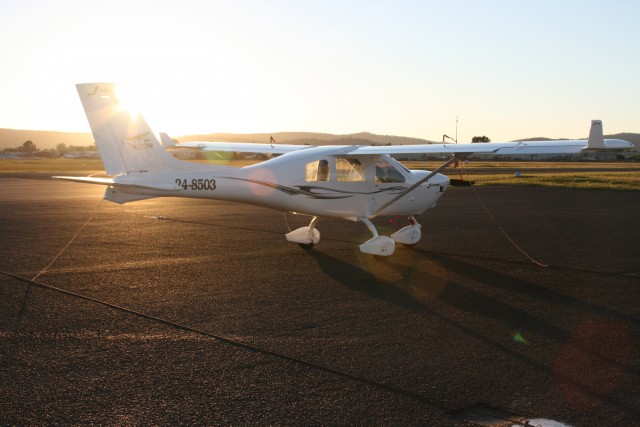
A Jabiru J-230D – Photo: Owen Zupp
Things weren’t looking good.
The next morning I was scheduled to depart Essendon and reenact the historic air mail flight undertaken by Maurice Guillaux in 1914. As I sat in my air-conditioned hotel room I logged onto the digital service, only to find that the weather forecast seemed endless with ’˜clouds on the ground’ at critical locations and line after line of low clouds and heavy rain. I flicked the pages on my iPad between the weather radars for Mount Gambier and Melbourne, endeavouring to get a clearer picture of the waves of water blowing in from the southwest.
Was there a possible route out of Melbourne to the west with lower hills and a higher cloud base? I entered in alternate flight plans on the iPad app and compared how much extra time such a plan would cost, and then converted that into fuel; there were viable options available. Still, the best news came from the MSL synoptic charts on the Bureau of Meteorology website. Maybe, just maybe, there will be a window of opportunity between the two deep cold fronts that threatened to ruin the centenary air mail flight.
And then I paused…
I had a world of information at my fingertips, mobile phones and mass media. 100 years ago, Guillaux had none of this and yet he set out from Melbourne bound for Sydney in his Bleriot monoplane; exposed to the elements and a simple railway line as his navigation system. On board were 1785 commemorative postcards and Australia’s first air freight ’“ orange juice and tea. His weather forecast was his line of sight through the spinning propeller. I had it easy.
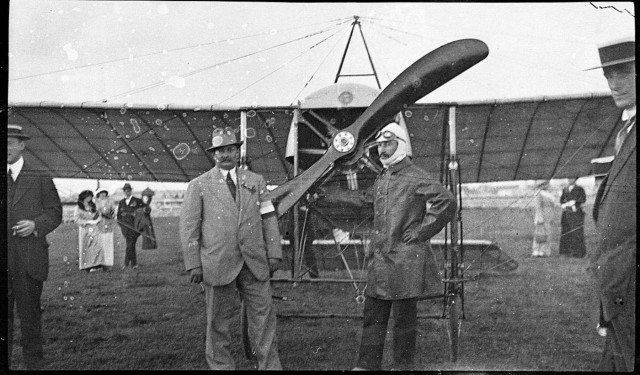
Guillaux and his Bleriot XI monoplane after the Melbourne-Sydney flight in 1914 – Photo: State Library of New South Wales | WikiCommons
It became even easier when the rain on the roof abated and breaks of blue sky appeared over Melbourne. By the time the many media commitments had been met and departure time loomed, things looked positively hopeful. Furthermore, each stage of the flight would have aircraft flying in company with my Jabiru J230D ’˜air mail’ aircraft. Veteran pilot, Aminta Hennessy, in her Cessna 182 was the support aircraft and offered an IFR alternative should the weather close in. For this stage she would be joined by a CT-4 and a Cessna 172 and all three would depart for me, offering some ’˜eyes in the sky’. As it transpired, as I climbed overhead Essendon, I could see for 100 miles and any reservations that I’d held melted away. The centenary air mail flight was underway.
Very Different Times.
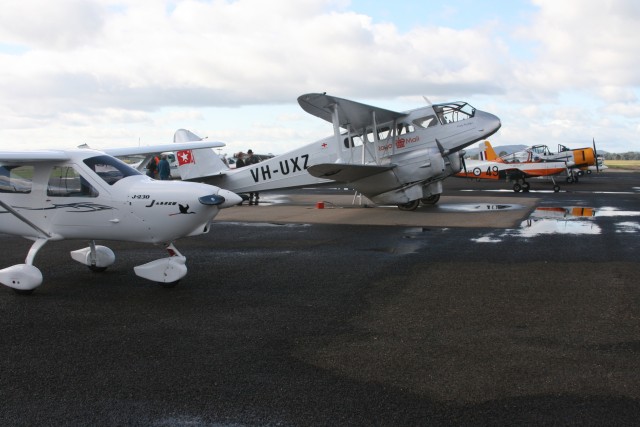
The Jabiru in the foreground and DH Dragon in the background – Photo: Owen Zupp
There is nothing quite as relaxing as flying over open fields with blue sky overhead and a big strip of highway and railway line to tell you where to go. In my enclosed cabin with GPS, EFIS, and cabin heater, I spared a thought for Guillaux battling turbulence and headwinds, the cold winter slipstream biting at his cheeks. On his journey, relief came when he was swamped by the warmth of the people he met along the way. Over three days he landed at Seymour and Wangaratta in Victoria, before crossing the border and making stops at Albury, Wagga Wagga, Harden, Goulburn, and the Sydney suburb of Liverpool. His final port of call was Moore Park, where he was met by the Governor-General.
This flight would also take three days, although not out of necessity, as the Jabiru cruised at a comfortable 120 knots and had five hours endurance in its fuel tanks. Along the way I would orbit overhead townships such as Seymour, Euroa, Glenrowan, and Moss Vale to recognize their part in the original flight. Still, times had changed, and Mangalore would step in for Seymour, and Mittagong was added to represent Guillaux’s weather-aborted attempt to land at Moss Vale. Temora and Benalla were added also on the strength of their local aviation communities. A Moore Park landing was considered, but a Bankstown destination was agreed upon.
The flight was the culmination of 18 months of planning for the Aviation Historical Society of NSW (AHSA), under the management of Tom Lockley. Along with Judy Rainsford, Anthony Coleiro, and an enthusiastic team they had considered everything from carrying another 1785 postcards to organizing classic aircraft such as a deHavilland Dragon Rapide and a Wirraway to keep the Jabiru from getting lonely. If only Guillaux had been so fortunate.
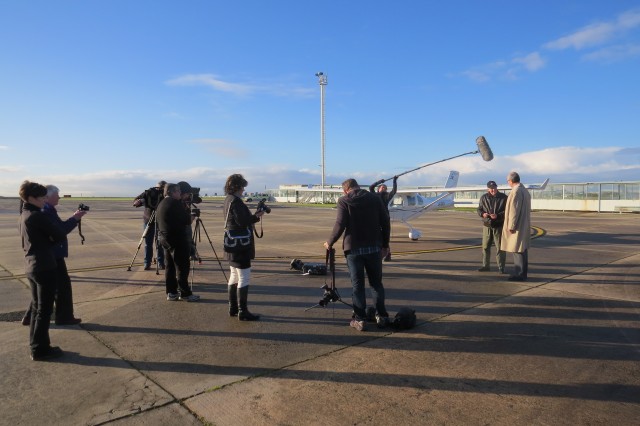
Media with the French Consul – Photo: Owen Zupp
Onwards to Albury.
With Melbourne and the Kilmore Gap behind, the first stop at Mangalore was made amidst multiple training aircraft and a good many birds. In a trend that was set to continue, the townspeople and media turned out to welcome the air mail troupe with the warmest of welcomes. It was a tremendous start, and soon we were all underway again, this time with a Winjeel as a companion.
Fog patches still lingered here and there as I leveled out and the greenness of the paddocks indicated a good amount of rain had been forthcoming this winter, hence the prevalence of birdlife at every turn. Birds of another type were floating down as I passed well clear near Euroa and soon Benalla loomed ahead.
The last of our aircraft to arrive, I was astounded at the array of aircraft parked to meet us. Aside from the military trainers were gliders and tug aircraft and a pristine silver deHavilland Dragon Rapide, complete with ’œRoyal Mail’ appropriately emblazoned on its flanks. Marshallers in high-visibility vests guided me in as people and cameras gathered behind them. There was another warm welcome in the museum, kind words, and an exchange of gifts before we set ourselves to depart again. Short sectors in the air and short stops on the ground added to the excitement of the day and all the while the skies smiled upon us.
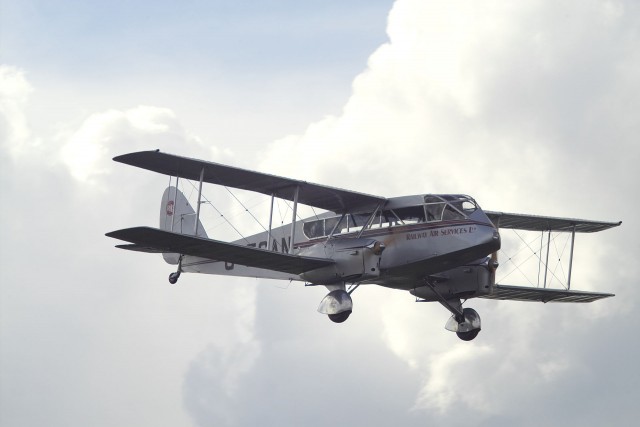
A de Havilland DH.84 Dragon (reg: G-ECAN) – Photo: Nigel Ish | WikiCommons
At Wangaratta, strong crosswinds challenged us, but we all managed to arrive safely. After a few passes, even the Dragon executed a wonderful landing in trying tailwheel conditions. Here it was time for a sausage sizzle and a coffee to keep the chill of the wind at bay. Again the township had attended in force and an old airline friend was among their number. I had parked the Jabiru into the wind, but I still kept one eye on the windsock should the gusts become stronger. In fact, by the time we taxied for Albury, the air had calmed to a constant breeze straight down the runway. I turned left after takeoff and looked back at the crowd still lingering on the tarmac before levelling the wings and setting course for Albury.
By the time I was to call Albury control tower, the radio frequency was abuzz. Our aircraft were inbound, other aircraft were departing, and an RPT turboprop was in the mix. I couldn’t get a word in so I decided to loiter with intent and take in the beautiful landscape beneath me until finally my turn came and I joined my fellow pilots by the fuel bowser at Albury. Significantly, the historic Ulver DC-2 from the 1934 air race sat only a short distance away and my thoughts again drifted to Guillaux and the other pioneer aviators.
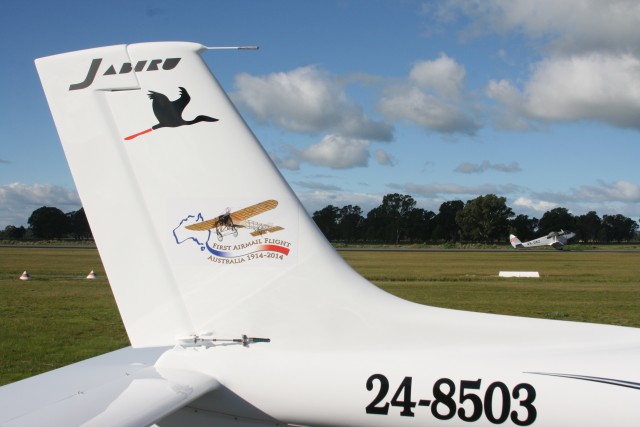
Special air mail logo on the tail – Photo: Owen Zupp
Bound for Harden.
That night, as the temperature dropped, we enjoyed a warm meal at our lodgings before I retired early to review the next day’s plans. Sydney was experiencing gale-force winds and another cold front was showering Melbourne. Meanwhile, the air mail flight sat comfortably in an area of high pressure between the two weather systems. The only consideration was fog the next morning as I turned off the light.
And fog there was…and ice. When we arrived at the airport the fog was already beginning to dissipate, but a coating of ice shrouded each and every airplane. In our favor was the fact that there was only a couple of hours flight time today, so a delay would not cause any ’˜last light’ issues. The only complication was the coordination of the various organizations meeting us at our ports of call.
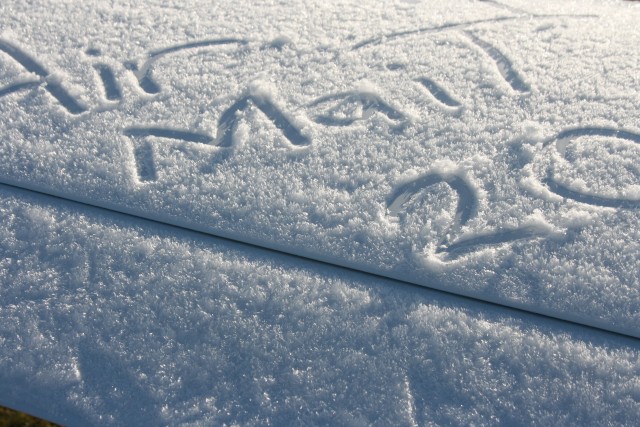
Cold weather makes for fun messages – Photo: Owen Zupp
Great care was taken to ensure that all of the aircraft were free of ice before long engine runs slowly brought engine temperatures into the green band. The airliners departed Albury with their propeller tips leaving spiraling rings of white vapor in their wake – now it was our time.
The short hop across to Wagga was again a matter of following the freeway. I spotted the airfield from some distance out, but I was cheating. I had flown ’˜bank runs’ out of Wagga in the 90’s and, in a note of history, my Dad had first solo’d there in 1947. On the ground, the packed tarmac boasted the Rapide, a Wirraway trainer, a canary Piper Cub, and an Ercoupe among their number. Kenny Love and Andrew Bishop from the Temora Aviation Museum were there and more cups of coffee were gratefully accepted.
Judy, Tom, and Tony did what they do so well, and brought the significant history behind the event to the gathering with well chosen words. The enthusiasm was tangible and Tom even managed to secure a ride to Temora in the Wirraway; I was just a tad envious. As the plan dictated, I was the last to depart again and it was the best seat in the house as I watched the array of classic aircraft take to the skies and set course for Temora.
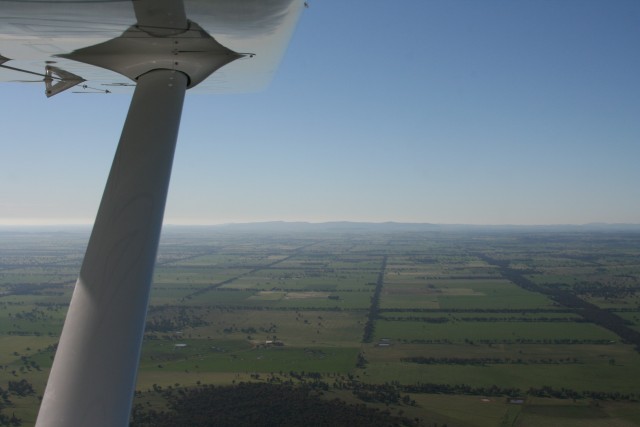
In flight – Photo: Owen Zupp
The Temora Aviation Museum is a favorite destination for my family, with a photo of my Dad’s shattered fighter cockpit featured on the wall. The museum slid beneath me on the downwind leg before I rolled into a base turn back towards the runway. Woomf! I barely had time to react as three large hawks swept past my cockpit. I wondered if Guillaux had dodged so much wildlife on his flight.
As I parked the Jabiru, there were a good many familiar faces in the gathering. Unfortunately there was not enough time to catch up with folks and wander the Museum’s halls. The ice that morning had delayed us and Harden’s population was on the phone and waiting. Kenny was to escort us on the last leg of the day and again Tom had scored a ride, this time in the little yellow Cub – I suppressed a slight green tinge of envy.
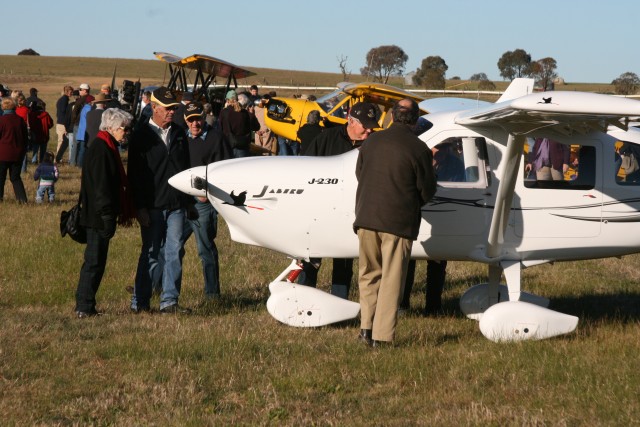
Group shot – Photo: Owen Zupp
The Harden airstrip runs the length of the town’s racecourse with a bit of a slope and a few bumps along its surface. However, it was the gathering of cars and people that really caught my attention. It seemed that half the population had come to greet the flight. I orbited overhead at the request of the media below before lining up on the orange gravel airstrip. Over the fence and into the landing flare…not again…a bird! I don’t know who ducked first but somehow the hawk neither smashed into my windscreen nor even thumped into the tailplane. I rocked and rolled and considered a go-around, but finally with the wings level I eased the little Jabiru back to earth for an exciting arrival.
The array of aircraft now sat lined up on the race course, complemented by a formation flying team from Canberra and an antique Avro Cadet. Following the formalities, the good people of Harden crossed the fence line and mingled with the pilots and airplanes with a good many children securing the opportunity to sit in a cockpit for the first time. The sense of community was everywhere.
Harden had been integral on the flight in 1914, as Guillaux’s aborted attempts to reach Goulburn had seen him stay there for more than the single night we would be hosted. Even so, we dined and slept in the Carrington Hotel. The very same lodgings where the Frenchman had stayed 100 years before. Over dinner, mention was made of a marker that the citizens of Harden had created to aid Guillaux in finding their town and that we would be able to see it the next morning. For now, it was time to rest and ready ourselves for the final day.
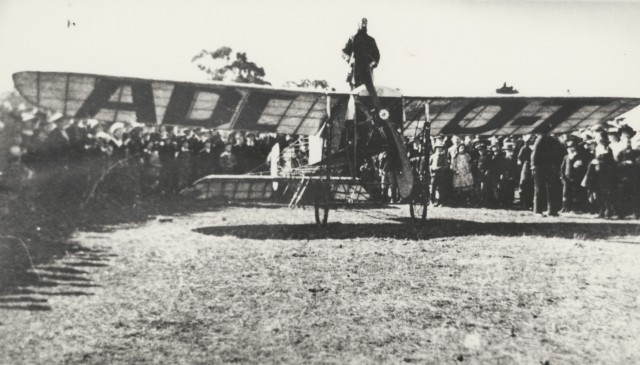
Guillaux and his Bleriot XI monoplane after the Melbourne-Sydney flight – Photo: National Library of Australia | WikiCommons
Heading Home.
Harden’s marker for Guillaux was a circle of concrete that now lies near the school under the eyes of the grazing cattle. Almost forgotten, it is a silent testament to the significance of the event a century before. A mere sprinkling of lime in a circle or a fire would not suffice, and the town had been determined to create a substantial signal to the French pilot. As I stood in the circle with other members of the air mail group, I truly felt a sense of history about the place.
When we arrived at the aircraft, the ice on the wings was even thicker than the night before at Albury. Once again we waited and wiped until the airframes were clear and clean, but now we were behind schedule for the grand finale at Bankstown.
Harden now farewelled us and a short time later Goulburn greeted us. Local dignitaries, antique cars, and ladies in period dress set the tone for a warm but whirlwind stop. The efforts of the community were astounding, and I sighted an elder statesman in a wheelchair with a pair of RAAF wings sewn to his jacket. I made a point of chatting with him, for the people and not merely the airplanes along the way had stories of our nation’s aviation heritage.
The crowd at Mittagong rivaled Harden, but was not a total surprise. It is my home airfield and I had been receiving text massages at Goulburn asking about my arrival time and reminding me not to make a mess of the landing. Fortunately I didn’t, and I was greeted by the hugs of my wife and kids and a long line of interested onlookers. And again, they had the chance to be up-close-and-personal with aircraft that included the beautifully restored Aero 145.
Yet another cup of coffee later I was on the way with a deHavilland ’˜Beaver’ ahead and Chris Byrne flying the Aero over my shoulder. Over Picton, I was joined by the Channel 9 helicopter that went on to shadow my flightpath for the remaining miles to Bankstown. The camera lens glinted outside the helicopter’s open door and the sun started to slip lower on the opposite side of the Jabiru.
Within minutes I was crossing the runway threshold at Bankstown Airport and three days of absolute enjoyment was drawing to a close. I parked the Jabiru and climbed out to be met by the French Consul General, French guards in period costume, and an array of media representatives. All too soon the flight was now over.
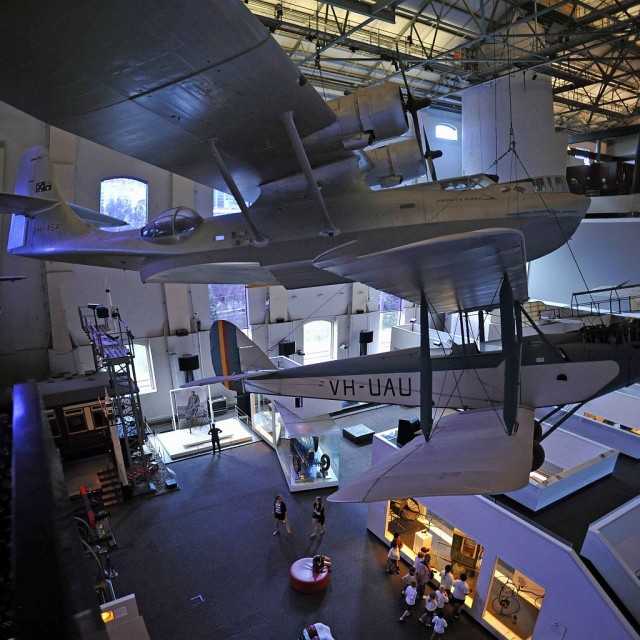
Aircraft Hall at the Powerhouse Museum in Sydney – Photo: Merryjack | FlickrCC
A French Revolution.
It was Bastille Day, and that night we delivered the air mail ceremoniously to the French and government dignitaries that had come together at the Powerhouse Museum. Specially addressed letters I had been handed by officials in Melbourne were now handed over to their counterparts in Sydney. A good deal of French champagne was flowing and there was genuine pride shown in their countryman who had achieved this memorable flight in the Antipodes.
Hanging from the roof was Guillaux’s original Bleriot monoplane that had made the flight so many years ago. As I looked at it, I contemplated how far we had come in a century and how much more difficult the journey had been for the brave Frenchman. I had followed Maurice Guillaux’s lead, but we were worlds apart in the challenges that were faced. Still, it was a flight I will always remember. The chance to carry the air mail….100 years on.
This is a guest post written by Owen Zupp for AirlineReporter. Be sure to check out his awesome books 50 Tales of Flight and 50 More Tales of Flight.
Thank you for this awesome experience. I’ve never been to any of those places but I felt a small amount of the wonder that you must have experienced. What an incredible opportunity that shows how much people still care about aviation and how important it is to all of us.